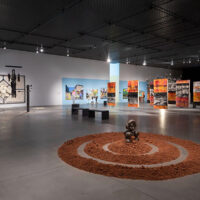Estratos II
2019 - Sculpture (Sculpture)
100 x 760 x 40 cm
Cynthia Gutiérrez
Estratos II by artist Cynthia Gutiérrez features a large white plinth with a transversal cut through the lower half, revealing a collection of archeological objects. These pieces of history have seemingly been lost to time and have lived covered under a sterile exterior. To create the ceramic objects for this project, Gutiérrez worked closely with an artist that creates Mesoamerican replicas. Typically a plinth functions to present, support or stabilize an artwork or object, however, Gutiérrez’s work reveals that this foundation also carries an invisible history—remains buried under the surface of the present. As such, the work becomes a metaphor for all histories that are continuously replicated, transferred, and sustained from generation to generation. With this sculpture, Gutiérrez refers to her concern for a world that is about to become extinct. E stratos II alludes to the transient nature of humankind and its histories, its symbols, and idols.
Cynthia Gutiérrez is one of the leading figures of contemporary art in Mexico. Throughout her research-based projects, Gutiérrez navigates the relationship between past and present, memory and oblivion. Her work examines how time impacts both the symbolic and the material world, and how concepts such as nationalism, victory, and triumph are the result of a particular moment of history that could vanish with time. Gutiérrez has utilized a number of mediums including sculpture, video, painting, drawings, and tapestries to investigate the ways in which identity is embedded in objects.
Colors:
Related works sharing similar palette
» see more

© » ARTNEWS RETROSPECTIVE
Howardena Pindell on the Exclusion of Black Artists in the 1980s – ARTnews.com Skip to main content By Alex Greenberger Plus Icon Alex Greenberger Senior Editor, ARTnews View All January 14, 2021 1:13pm ©ARTnews Over the past several years, museums and galleries have made concerted efforts to show work by Black artists, responding to growing calls for equity...

© » ARTS EQUATOR
Nghệ thuật Xin giấy phép Triển lãm ở Việt Nam | ArtsEquator Skip to content Tại một đất nước như Việt Nam, nơi có những yêu cầu không rõ ràng về việc trưng bày, Linh Lê nhấn mạnh rằng chỉ cần một thứ tưởng chừng đơn giản như xin giấy phép triển lãm có thể trở thành một cách kiểm duyệt biểu đạt nghệ thuật...
Related works found in the same semantic group
» see more

© » KADIST
Malik Nejmi
2014La Chambre Marocaine series is a means to reconnect personally to his connection to family history and objectively assess the process of reconnection...

© » KADIST
Claudia Gutiérrez
2016The title for this body of work, Poco se gana hilando, pero menos mirando , is based on a Spanish saying that underestimates feminized crafts or tasks, implying that it is better for a woman to be doing ‘something’, no matter how useless it is, instead of just doing nothing...




